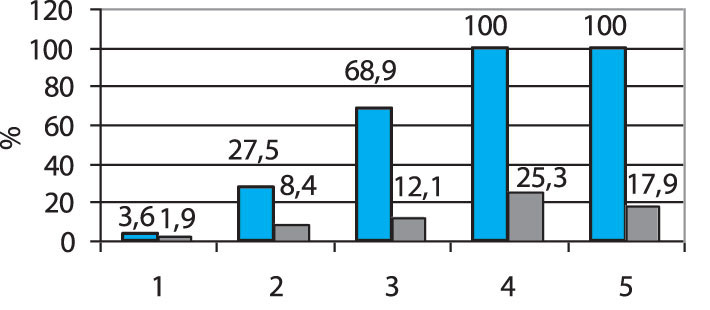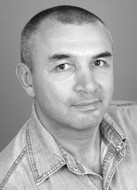Academic rifle shooting sport optimizing initiatives for Russian GTO complex tests
Фотографии:
ˑ:
PhD, Associate Professor V.A. Gromov1
R.G. Shaikhetdinov1
A.A. Bakushin1
PhD S.V. Mikhailova2
1South Ural State University (SRU), Chelyabinsk
2Financial University under the Government of the Russian Federation - Chelyabinsk Branch, Chelyabinsk
Keywords: university, mass shooting practices, GTO, success rate.
Background. Lately the national sport sector policy makers have given a high priority to the initiatives to improve the test methods, tools and models in trainings for the GTO Complex tests [4]. Having analyzed the available data on the academic pneumatic rifle shooting tests, we found the students’ shooting skills being relatively low on average: see Figure 1 hereunder. We believe, the shooting skills may be improved if the rules violations and errors in the shooting competitions are analyzed and the shooting practice timeframes are optimized [5, 7].

Figure 1. Students’ GTO Complex rifle shooting test data
Objective of the study was to offer academic mass rifle shooting practice scheduling and group practice optimizing initiatives for success in the GTO Complex tests.
Methods and structure of the study. For the students shooting skills improving purposes, we offered them additional scheduled practice sessions and short-term courses. The process optimizing model was tested on the following Experimental Groups: EG1 trained for 2 weeks (4 sessions); EG2 trained for one month (8 sessions); EG3 trained for 2 months (16 sessions); and EG4 trained for 4 months (one semester of 32 sessions); with the group progress rated versus that in the TPG (Theory Prioritizing Group) and Reference Group (RG) trained as required by the traditional practical GTO shooting practice dominated model; with each group made of 32-35 people.
The EGs were trained by traditional training tools and differed only in the training periods. The TPG trainings were dominated by theoretical studies with a special emphasis on the self-reliant trainings [3]. Two weeks prior to the GTO Complex tests the TPG was given instructions and theoretical briefing materials on how to succeed in the GTO Complex tests. Upon completion of the training course, each group functionality and shooting success rates were fixed in the GTO Complex shooting tests.
Study findings and discussion. The EG functionality rates showed insignificant variations for the study period, except for the Ruffier index: see Table 1. The body systems functionality rates were tested only upon completion of the trainings in the GTO Complex tests, including: heart rate (HR); heart rate variability (HRV); heart rate amplitude (HRA); and tension index (TI): see Table 1. The EG test rates were compared with the RG test rates during the GTO Complex shooting tests.
Table 1. Heart functionality rates in the GTO Complex shooting tests
|
Group |
HR, bpm |
Heart rate variability, s |
Heart rate amplitude, % |
Tension index, units |
Ruffier index, units |
|
RG |
126±7,5 |
0,03±0,007 |
81±3,5 |
4900±365 |
11,5±2,21 |
|
EG1 |
113±4,5 |
0,04±0,009 |
77±2,7 |
3100±320 |
11,2±1,88 |
|
EG2 |
98±5,6 |
0,05±0,011 |
68±3,3 |
1200±370 |
9,7±1,22 |
|
EG3 |
92±3,8 |
0,07±0,012 |
51±4,5 |
310±40 |
8,1±1.07 |
|
EG4 |
83±3,2 |
0,06±0,010 |
48±5,9 |
400±35 |
9,3±1,87 |
The EG4 was tested with a moderate tension of the body systems i.e. insignificant growth of HR, HRA and TI versus some reduction in HRV. The EG1 and EG2 were tested with somewhat excessive tension and expressed activity of the sympathetic adrenalin system; with HR, HRA and TI tested to grow in most of the group members: see Table 1. Neither of the EGs was tested with an overstrain, save for a few cases – that may be interpreted as indicative of reasonably fast adaptation. The EG3 and EG4 were tested with relatively sharp declines in HR and HRV in the rest breaks during the shooting competitions. The shooting success rates were found correlated with the heart functionality resource mobilization rates and rehabilitation rates following the prestart fever. Given in Table 2 hereunder are the training periods versus the GTO Complex shooting test success rates.
Table 2. Training periods versus the GTO Complex shooting test success rates
|
Group |
Test time |
M |
M |
р< |
s |
E |
A |
V, % |
GTO, % |
|
TPG |
Prior |
11,1 |
1,26 |
0,05 |
7,14 |
-0,38 |
0,38 |
64,3 |
31,3 |
|
RG |
Prior |
5,69 |
0,43 |
4,98 |
0,97 |
1,12 |
87,5 |
12,9 |
|
|
EG1 |
Prior |
5,5 |
0,9 |
0,05 |
5,17 |
3,12 |
1,53 |
93,6 |
15,2 |
|
After |
10,5 |
1,13 |
6,49 |
0,18 |
0,65 |
61,8 |
24,2 |
||
|
EG2 |
Prior |
5,7 |
0,88 |
0,05 |
5,06 |
1,07 |
1,18 |
87,4 |
18,2 |
|
After |
16,8 |
1,29 |
7,44 |
0,04 |
0,22 |
44,3 |
69,7 |
||
|
EG3
|
Prior |
5,3 |
0,78 |
0,05 |
4,46 |
1,28 |
1,19 |
83,2 |
6,1 |
|
After |
19,5 |
1,39 |
8,01 |
-0,13 |
0,09 |
41,1 |
78,8 |
||
|
EG4 |
Prior |
6,1 |
0,93 |
0,05 |
5,36 |
-0,45 |
0,75 |
87,9 |
12,1 |
|
After |
21,3 |
1,35 |
7,79 |
-0,59 |
0,41 |
36,6 |
84,8 |
The study data was indicative of the theoretical training model applied in the TPG being beneficial for progress in the GTO Complex shooting tests. The TPG shooting success rate (31.3%) was 18.4% higher than that of the RG despite the fact that the prior group test rates were much the same – that may be due to the theoretical advantage. A particularly high progress was made by the EG (34.2% plus), with the excess rates (E) in the EG tested to sharply fall, distribution notably leveled and irregularities in the shooting success rates less expressed. It should be noted that the academic curriculum provides limited opportunities for mass long-term shooting practices. The EG under the study showed significant progress (24.2% plus) in the shooting skills that made it possible to bridge the gaps with the other GTO Complex tests within the relatively short timeframes. EG2, for instance, showed progress of up to 69.7% in the GTO Complex shooting tests, with the growth versus the pre-experimental test rates peaking at 51.5%, to secure success in the GTO Complex shooting tests.
Conclusion. The study data and analyses have demonstrated that the additional academic shooting practice model taking 8 sessions were the most efficient for progress in the GTO Complex shooting tests. Successful tests in the ‘technical disciplines’ of the GTO Complex tests may give the means to save a significant resource for account of the key complex test exercises.
References
- Gromov V.A., Shklyaev V.V., Skutin A.V. Povyshenie rezultativnosti v vypolnenii kompleksa GTO v universitete [Increasing effectiveness in performance of the GTO complex at the university]. Vestnik Chelyabinskogo gosudarstvennogo pedagogicheskogo universiteta, 2016, no. 10, pp. 24-29.
- Zubrilov R.A. Stanovlenie, razvitie i sovershenstvovanie tekhniki strelby v biatlone [Formation, development and perfection of shooting technique in biathlon]. 2nd ed., rev., sup.. Moscow: Sovetskiy sport publ., 2013, 352 p.
- Kuzmenko G.A. Teoreticheskaya podgotovka yunykh sportsmenov v sisteme realizatsii zadach intellektualnogo razvitiya lichnosti [Theoretical training of junior athletes in personality intellectual development tasks implementation system]. Kultura fizicheskaya i zdorovye, Voronezh, 2011, no. 4, pp. 39-43.
- Matveyev L.P. Teoriya i metodika fizicheskoy kultury [Theory and Methods of Physical Culture]. 3rd ed., rev., sup.. Moscow: Fizkultura i sport, SportAkademPress publ., 2008.
- Machula A.F. Srednie pokazateli psikhofizicheskoy podgotovlennosti yunoshey 19-20 let, zanimayuschikhsya pulevoy strelboy. V 2 t. T. 1 [Average indices of mental and physical fitnees of 19-20 year-old males practicing bullet shooting. In 2 vols. Vol. 1]. Tula: TSPU publ., 2010, pp 155-159.
- Ratov I.P., Popov G.I., Loginov A.A. et al. Biomekhanicheskie tekhnologii podgotovki sportsmenov [Biomechanical technologies of athletic training]. Moscow: Fizkultura i sport publ., 2007, 120 p.
- Shaykhetdinov R.G., Gromov V.A. Dostizhenie vypusknikom universiteta psikhofizicheskoy gotovnosti k professionalnoy deyatelnosti [University graduate's psychophysical vocational fitness: methods of achievement]. Teoriya i praktika fizicheskoy kultury, 2016, no. 3, pp. 26-28.
- Lubysheva L.I., Cherepov E.A. The Structure of Applied Military Competence of Military Science Department Students in the Traditional University. Human. Sport. Medicine, 2016, vol. 16, no. 3, pp. 67–74. (in Russ.) DOI: 10.14529/hsm160308.
Corresponding author: camp048@mail.ru
Abstract
Objective of the study was to offer the academic mass rifle shooting practice scheduling and group practice optimizing initiatives for success in the GTO Complex tests. The process optimizing model was tested on the following Experimental Groups: EG1 trained for 2 weeks (4 sessions); EG2 trained for one month (8 sessions); EG3 trained for 2 months (16 sessions); and EG4 trained for 4 months (one semester of 32 sessions); with the group progress rated versus that in the TPG (Theory Prioritizing Group) and Reference Group (RG) trained as required by the traditional practical GTO shooting practice dominated model; with each group composed of 32-35 people. The EG trainings were designed to include the traditional training tools and varied in the training periods. The TPG trainings were dominated by the theoretical studies with a special emphasis on self-reliant learning. The groups were offered additional scheduled sessions and short-term focused training courses for the shooting mastery excelling purposes. The study data and analyses demonstrated benefits of the short-term focused trainings for the GTO Complex tests including 8 sessions. The process optimizing model showed benefits in the technical aspects of the training for the GTO Complex tests and gives the means to accumulate significant resource for success in the key combined shooting events.



